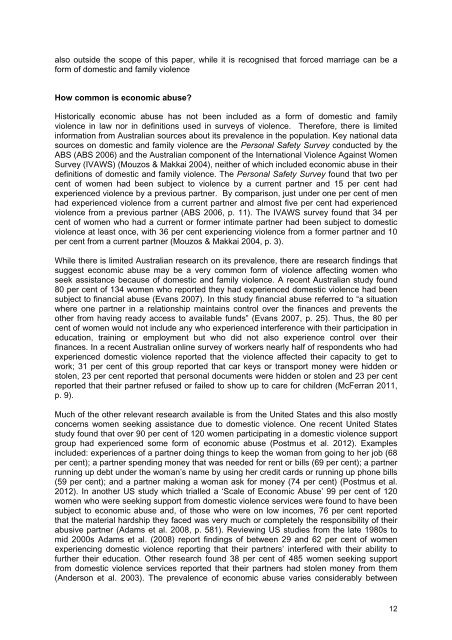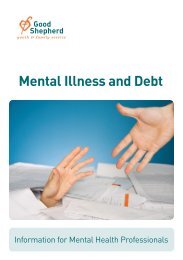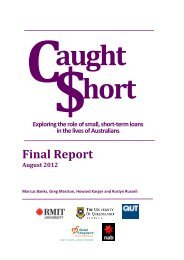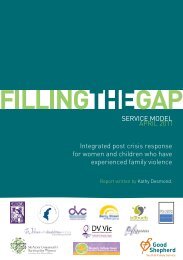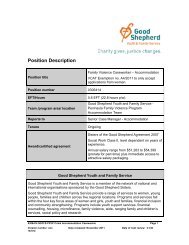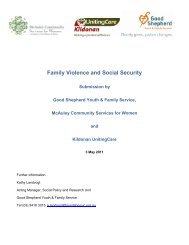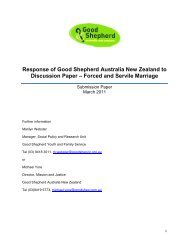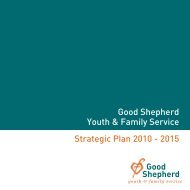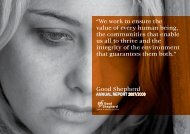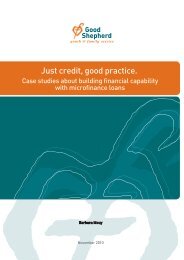Spotlight on Economic Abuse: a Literature and Policy Review
Spotlight on Economic Abuse: a Literature and Policy Review
Spotlight on Economic Abuse: a Literature and Policy Review
Create successful ePaper yourself
Turn your PDF publications into a flip-book with our unique Google optimized e-Paper software.
also outside the scope of this paper, while it is recognised that forced marriage can be a<br />
form of domestic <strong>and</strong> family violence<br />
How comm<strong>on</strong> is ec<strong>on</strong>omic abuse?<br />
Historically ec<strong>on</strong>omic abuse has not been included as a form of domestic <strong>and</strong> family<br />
violence in law nor in definiti<strong>on</strong>s used in surveys of violence. Therefore, there is limited<br />
informati<strong>on</strong> from Australian sources about its prevalence in the populati<strong>on</strong>. Key nati<strong>on</strong>al data<br />
sources <strong>on</strong> domestic <strong>and</strong> family violence are the Pers<strong>on</strong>al Safety Survey c<strong>on</strong>ducted by the<br />
ABS (ABS 2006) <strong>and</strong> the Australian comp<strong>on</strong>ent of the Internati<strong>on</strong>al Violence Against Women<br />
Survey (IVAWS) (Mouzos & Makkai 2004), neither of which included ec<strong>on</strong>omic abuse in their<br />
definiti<strong>on</strong>s of domestic <strong>and</strong> family violence. The Pers<strong>on</strong>al Safety Survey found that two per<br />
cent of women had been subject to violence by a current partner <strong>and</strong> 15 per cent had<br />
experienced violence by a previous partner. By comparis<strong>on</strong>, just under <strong>on</strong>e per cent of men<br />
had experienced violence from a current partner <strong>and</strong> almost five per cent had experienced<br />
violence from a previous partner (ABS 2006, p. 11). The IVAWS survey found that 34 per<br />
cent of women who had a current or former intimate partner had been subject to domestic<br />
violence at least <strong>on</strong>ce, with 36 per cent experiencing violence from a former partner <strong>and</strong> 10<br />
per cent from a current partner (Mouzos & Makkai 2004, p. 3).<br />
While there is limited Australian research <strong>on</strong> its prevalence, there are research findings that<br />
suggest ec<strong>on</strong>omic abuse may be a very comm<strong>on</strong> form of violence affecting women who<br />
seek assistance because of domestic <strong>and</strong> family violence. A recent Australian study found<br />
80 per cent of 134 women who reported they had experienced domestic violence had been<br />
subject to financial abuse (Evans 2007). In this study financial abuse referred to “a situati<strong>on</strong><br />
where <strong>on</strong>e partner in a relati<strong>on</strong>ship maintains c<strong>on</strong>trol over the finances <strong>and</strong> prevents the<br />
other from having ready access to available funds” (Evans 2007, p. 25). Thus, the 80 per<br />
cent of women would not include any who experienced interference with their participati<strong>on</strong> in<br />
educati<strong>on</strong>, training or employment but who did not also experience c<strong>on</strong>trol over their<br />
finances. In a recent Australian <strong>on</strong>line survey of workers nearly half of resp<strong>on</strong>dents who had<br />
experienced domestic violence reported that the violence affected their capacity to get to<br />
work; 31 per cent of this group reported that car keys or transport m<strong>on</strong>ey were hidden or<br />
stolen, 23 per cent reported that pers<strong>on</strong>al documents were hidden or stolen <strong>and</strong> 23 per cent<br />
reported that their partner refused or failed to show up to care for children (McFerran 2011,<br />
p. 9).<br />
Much of the other relevant research available is from the United States <strong>and</strong> this also mostly<br />
c<strong>on</strong>cerns women seeking assistance due to domestic violence. One recent United States<br />
study found that over 90 per cent of 120 women participating in a domestic violence support<br />
group had experienced some form of ec<strong>on</strong>omic abuse (Postmus et al. 2012). Examples<br />
included: experiences of a partner doing things to keep the woman from going to her job (68<br />
per cent); a partner spending m<strong>on</strong>ey that was needed for rent or bills (69 per cent); a partner<br />
running up debt under the woman’s name by using her credit cards or running up ph<strong>on</strong>e bills<br />
(59 per cent); <strong>and</strong> a partner making a woman ask for m<strong>on</strong>ey (74 per cent) (Postmus et al.<br />
2012). In another US study which trialled a ‘Scale of Ec<strong>on</strong>omic <strong>Abuse</strong>’ 99 per cent of 120<br />
women who were seeking support from domestic violence services were found to have been<br />
subject to ec<strong>on</strong>omic abuse <strong>and</strong>, of those who were <strong>on</strong> low incomes, 76 per cent reported<br />
that the material hardship they faced was very much or completely the resp<strong>on</strong>sibility of their<br />
abusive partner (Adams et al. 2008, p. 581). <strong>Review</strong>ing US studies from the late 1980s to<br />
mid 2000s Adams et al. (2008) report findings of between 29 <strong>and</strong> 62 per cent of women<br />
experiencing domestic violence reporting that their partners’ interfered with their ability to<br />
further their educati<strong>on</strong>. Other research found 38 per cent of 485 women seeking support<br />
from domestic violence services reported that their partners had stolen m<strong>on</strong>ey from them<br />
(Anders<strong>on</strong> et al. 2003). The prevalence of ec<strong>on</strong>omic abuse varies c<strong>on</strong>siderably between<br />
12


